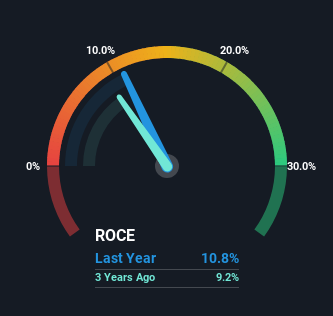- United Kingdom
- /
- Tobacco
- /
- LSE:BATS
British American Tobacco (LON:BATS) Shareholders Will Want The ROCE Trajectory To Continue
If we want to find a potential multi-bagger, often there are underlying trends that can provide clues. Amongst other things, we'll want to see two things; firstly, a growing return on capital employed (ROCE) and secondly, an expansion in the company's amount of capital employed. Ultimately, this demonstrates that it's a business that is reinvesting profits at increasing rates of return. So on that note, British American Tobacco (LON:BATS) looks quite promising in regards to its trends of return on capital.
Return On Capital Employed (ROCE): What Is It?
Just to clarify if you're unsure, ROCE is a metric for evaluating how much pre-tax income (in percentage terms) a company earns on the capital invested in its business. To calculate this metric for British American Tobacco, this is the formula:
Return on Capital Employed = Earnings Before Interest and Tax (EBIT) ÷ (Total Assets - Current Liabilities)
0.11 = UK£11b ÷ (UK£119b - UK£18b) (Based on the trailing twelve months to June 2024).
Thus, British American Tobacco has an ROCE of 11%. In absolute terms, that's a pretty standard return but compared to the Tobacco industry average it falls behind.
See our latest analysis for British American Tobacco

In the above chart we have measured British American Tobacco's prior ROCE against its prior performance, but the future is arguably more important. If you'd like to see what analysts are forecasting going forward, you should check out our free analyst report for British American Tobacco .
What Does the ROCE Trend For British American Tobacco Tell Us?
We're pretty happy with how the ROCE has been trending at British American Tobacco. The figures show that over the last five years, returns on capital have grown by 39%. That's a very favorable trend because this means that the company is earning more per dollar of capital that's being employed. In regards to capital employed, British American Tobacco appears to been achieving more with less, since the business is using 21% less capital to run its operation. If this trend continues, the business might be getting more efficient but it's shrinking in terms of total assets.
In Conclusion...
In summary, it's great to see that British American Tobacco has been able to turn things around and earn higher returns on lower amounts of capital. And investors seem to expect more of this going forward, since the stock has rewarded shareholders with a 50% return over the last five years. Therefore, we think it would be worth your time to check if these trends are going to continue.
If you'd like to know about the risks facing British American Tobacco, we've discovered 2 warning signs that you should be aware of.
While British American Tobacco may not currently earn the highest returns, we've compiled a list of companies that currently earn more than 25% return on equity. Check out this free list here.
Valuation is complex, but we're here to simplify it.
Discover if British American Tobacco might be undervalued or overvalued with our detailed analysis, featuring fair value estimates, potential risks, dividends, insider trades, and its financial condition.
Access Free AnalysisHave feedback on this article? Concerned about the content? Get in touch with us directly. Alternatively, email editorial-team (at) simplywallst.com.
This article by Simply Wall St is general in nature. We provide commentary based on historical data and analyst forecasts only using an unbiased methodology and our articles are not intended to be financial advice. It does not constitute a recommendation to buy or sell any stock, and does not take account of your objectives, or your financial situation. We aim to bring you long-term focused analysis driven by fundamental data. Note that our analysis may not factor in the latest price-sensitive company announcements or qualitative material. Simply Wall St has no position in any stocks mentioned.
About LSE:BATS
British American Tobacco
Provides tobacco and nicotine products to consumers in the Americas, Europe, the Asia-Pacific, the Middle East, Africa, and the United States.
Average dividend payer and fair value.
Similar Companies
Market Insights
Community Narratives



